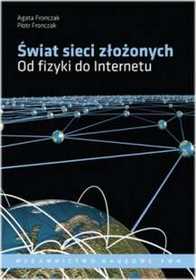World of complex networks
Agata Fronczak, Piotr Fronczak
Edition: first (in polish) |
Wydawnictwo Naukowe PWN 2009 |
ISBN: 978-83-01-15987-0 |
 Connections of neurons in the brain, friendships in society, food dependiencies in the ecosystem, economic links, transportation and telecommunication networks, and finally, the Internet and WWW - world in which we live can be, without doubt, named the world of complex networks. To understand it, we should know the mechanisms governing the evolution of each network separately. Or maybe not? Maybe there is one, the general rule, a universal key that unlock the whole world of complex networks at once? Connections of neurons in the brain, friendships in society, food dependiencies in the ecosystem, economic links, transportation and telecommunication networks, and finally, the Internet and WWW - world in which we live can be, without doubt, named the world of complex networks. To understand it, we should know the mechanisms governing the evolution of each network separately. Or maybe not? Maybe there is one, the general rule, a universal key that unlock the whole world of complex networks at once?
This book gives answers to the above questions. By bringing the reader into the world of networks, it shows the latest achievements of the science, bringing us closer to understanding how networks are formed, function and die. It is a comprehensive guide, giving relevant theory and methods of description and analysis of networks.
To understand the contents of the book only basic knowledge of mathematical analysis and probability theory is required. The authors, who are educated as physicists, have emphasized that the complexity of the issues presented in the book has grown slightly, and introduced elements of statistical physics can be understood also to sociologists, economists and biologists
The book is written in plain but colorful language, referring to the intuitive knowledge and experience of the reader. Numerous anecdotes, polonica, as well as historical and current interest add to the book specific lightness and intimacy.
(Prof. Danuta Makowiec, Intitute of Theoretical Physics and Astrophysics, Gdansk University)
|

Exercises and problems with solutions on thermodynamics and statistical physics
Agata Fronczak
Edition: first (in polish) |
Oficyna Wydawnicza Politechniki Warszawskiej 2006 |
ISBN: 83-7207-640-5 |

Thebook is primarily intended for students of physics.
The scope of the issues raised in it includes classical thermodynamics and statistical physics of equilibrium states.
The collection is divided into two parts. The first part concerns the thermodynamics and the second - statistical physics. Each part consists of three chapters, each of which contains about 40 exercises of varying difficulty. Some of them is simple and requires only adequate use of the formula given in the introduction, others require a bit more skill. In addition, all exercises have been grouped into packets with a brief theoretical introduction (containing the main concepts, models and methods) and arranged along with increasing levels of difficulty. In addition, in a large part of exercises links have been placed (see ref. 3.2b), to facilitate understanding of these exercises as well as notes, in which the author generalize the received results and dependencies. |

